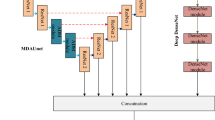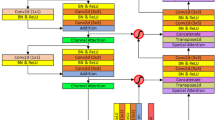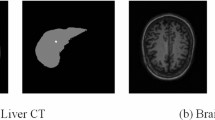Abstract
Purpose
Due to the complex structure of liver tumors and the low contrast with normal tissues make it still a challenging task to accurately segment liver tumors from CT images. To address these problems, we propose an end-to-end segmentation method for liver tumors.
Methods
The method uses a cascade structure to improve the network’s extraction of information. First, the Side-output Feature Fusion Attention block is used to fuse features at different levels and combine with attention mechanism to focus on important information. Then, the Atrous Spatial Pyramid Pooling Attention block is used to extract multi-scale semantic features. Finally, the Multi-scale Prediction Fusion block is used to fully fused the features captured at each layer of the network.
Result
To verify the performance of the proposed model and the effectiveness of each module, we evaluate it on LiTS and 3DIRCADb datasets and obtained Dice per Case of 0.665 and 0.719, respectively, and Dice Global of 0.812 and 0.784, respectively.
Conclusion
The proposed method is compared with the basic model 3D U-Net, as well as some mainstream methods based on U-Net variants, and our method achieves better performance on the liver tumor segmentation task and is superior to most segmentation algorithms.






Similar content being viewed by others
References
Campadelli P, Casiraghi E, Esposito A (2009) Liver segmentation from computed tomography scans: a survey and a new algorithm. Artif Intell Med 45(2–3):185–196
Long J, Shelhamer E, Darrell T (2015) Fully convolutional networks for semantic segmentation. In: Proceedings of the IEEE conference on computer vision and pattern recognition(CVPR), pp 3431–3440
Ronneberger O, Fischer P, Brox T (2015) U-Net: convolutional networks for biomedical image segmentation. In: International conference on medical image computing and computer-assisted intervention(MICCAI), Springer, pp 234–241
Li X, Chen H, Qi X, Dou Q, Fu C-W, Heng P-A (2018) H-denseunet: hybrid densely connected UNet for liver and tumor segmentation from CT volumes. IEEE T Med Imaging 37(12):2663–2674
Xi X-F, Wang L, Sheng VS, Cui Z, Fu B, Hu F (2020) Cascade u-resnets for simultaneous liver and lesion segmentation. IEEE Access 8:68944–68952
He K, Zhang X, Ren S, Sun J (2016) Deep residual learning for image recognition. In: Proceedings of the IEEE conference on computer vision and pattern recognition(CVPR), pp 770–778
Jin Q, Meng Z, Sun C, Cui H, Su R (2020) Ra-UNet: a hybrid deep attention-aware network to extract liver and tumor in CT scans. Front Bioeng Biotech 8:1471
Albishri A.A, Shah S.J.H, Lee Y (2019) Cu-net: cascaded U-Net model for automated liver and lesion segmentation and summarization. In: 2019 IEEE international conference on bioinformatics and biomedicine (BIBM), IEEE, pp 1416–1423
Hu J, Shen L, Sun G (2018) Squeeze-and-excitation networks. In: Proceedings of the IEEE conference on computer vision and pattern recognition(CVPR), pp 7132–7141
Xu Y, Cai M, Lin L, Zhang Y, Hu H, Peng Z, Zhang Q, Chen Q, Mao X, Iwamoto Y, Han X-H, Chen Y-W, Tong R (2021) Pa-resseg: a phase attention residual network for liver tumor segmentation from multiphase CT images. Med Phys 48(7):3752–3766
Chung M, Lee J, Park S, Lee CE, Lee J, Shin Y-G (2021) Liver segmentation in abdominal CT images via auto-context neural network and self-supervised contour attention. Artif Intell Med 113:102023
Oktay O, Schlemper J, Folgoc LL, Lee M, Heinrich M, Misawa K, Mori K, McDonagh S, Hammerla NY, Kainz B, Glocker B, Rueckert D (2018) Attention U-Net: learning where to look for the pancreas. arXiv preprint arXiv:1804.03999
Woo S, Park J, Lee J-Y, Kweon IS (2018) Cbam: convolutional block attention module. In: Proceedings of the European conference on computer vision (ECCV), pp 3–19
Liu T, Liu J, Ma Y, He J, Han J, Ding X, Chen C-T (2021) Spatial feature fusion convolutional network for liver and liver tumor segmentation from CT images. Med Phys 48(1):264–272
Chen X, Zhang R, Yan P (2019) Feature fusion encoder decoder network for automatic liver lesion segmentation. In: 2019 IEEE 16th international symposium on biomedical imaging (ISBI), IEEE, pp 430–433
Zhang Y, Zhong C, Zhang Y, Shi Z, He Z (2019) Semantic feature attention network for liver tumor segmentation in large-scale CT database. arXiv preprint arXiv:1911.00282
Çiçek Ö, Abdulkadir A, Lienkamp S.S, Brox T, Ronneberger O (2016) 3d U-Net: learning dense volumetric segmentation from sparse annotation. In: International conference on medical image computing and computer-assisted intervention(MICCAI), Springer, pp 424–432
Chen L-C, Papandreou G, Kokkinos I, Murphy K, Yuille AL (2017) Deeplab: semantic image segmentation with deep convolutional nets, atrous convolution, and fully connected crfs. IEEE T Pat Anal 40(4):834–848
Bilic P, Christ P.F, Vorontsov E, Chlebus G, Chen H, Dou Q, Fu C-W, Han X, Heng P-A, Hesser J, Kadoury S, Konopczynski T, Le M, Li C, Li X, Lipkovà J, Lowengrub J, Meine H, Moltz JH, Pal C et al (2019) The liver tumor segmentation benchmark (lits). arXiv preprint arXiv:1901.04056
Soler L, Hostettler A, Agnus V, Charnoz A, Fasquel J, Moreau J, Osswald A, Bouhadjar M, Marescaux J (2010) 3d image reconstruction for comparison of algorithm database: a patient specific anatomical and medical image database. IRCAD, Strasbourg, France, Tech. Rep,
Yu W, Fang B, Liu Y, Gao M, Zheng S, Wang Y (2019) Liver vessels segmentation based on 3d residual U-Net. In: 2019 IEEE international conference on image processing (ICIP), IEEE, pp 250–254
Milletari F, Navab N, Ahmadi S-A (2016) V-net: fully convolutional neural networks for volumetric medical image segmentation. In: 2016 fourth international conference on 3D vision (3DV), IEEE, pp 565–571
Wang J, Lv P, Wang H, Shi C (2021) Sar-U-Net: squeeze-and-excitation block and atrous spatial pyramid pooling based residual U-Net for automatic liver CT segmentation. arXiv preprint arXiv:2103.06419
Acknowledgements
This work was partially supported by the Science and Technology Foundation of Guizhou Province (No. ZK[2022]119), the National Science Foundation of China (NSFC, No.61662009) and the Guizhou Province Graduate Research Fund (YJSCXJH[2020]055.
Author information
Authors and Affiliations
Corresponding author
Ethics declarations
Conflict of interest
There is no conflict of interest.
Additional information
Publisher's Note
Springer Nature remains neutral with regard to jurisdictional claims in published maps and institutional affiliations.
Rights and permissions
About this article
Cite this article
Wu, Y., Shen, H., Tan, Y. et al. Automatic liver tumor segmentation used the cascade multi-scale attention architecture method based on 3D U-Net. Int J CARS 17, 1915–1922 (2022). https://doi.org/10.1007/s11548-022-02653-9
Received:
Accepted:
Published:
Issue Date:
DOI: https://doi.org/10.1007/s11548-022-02653-9




